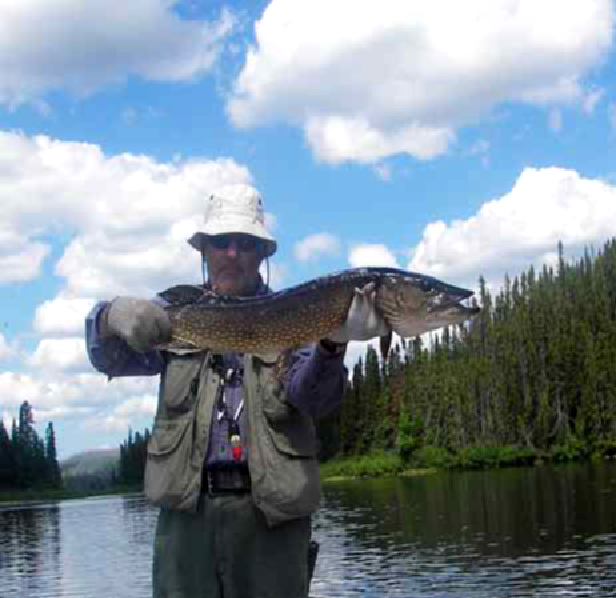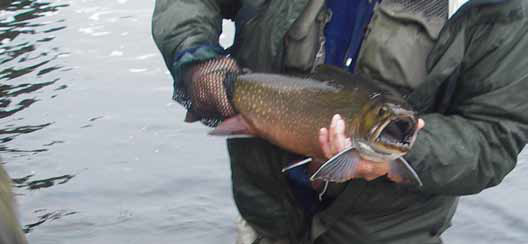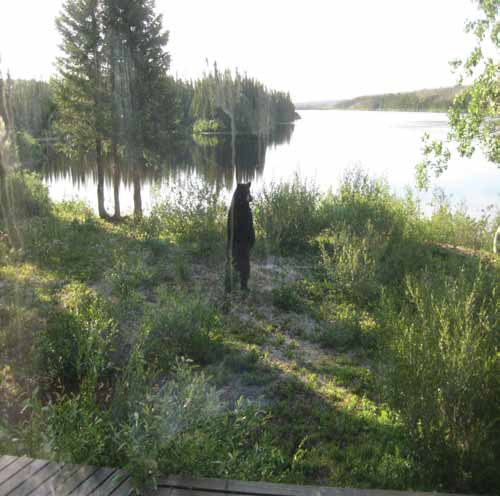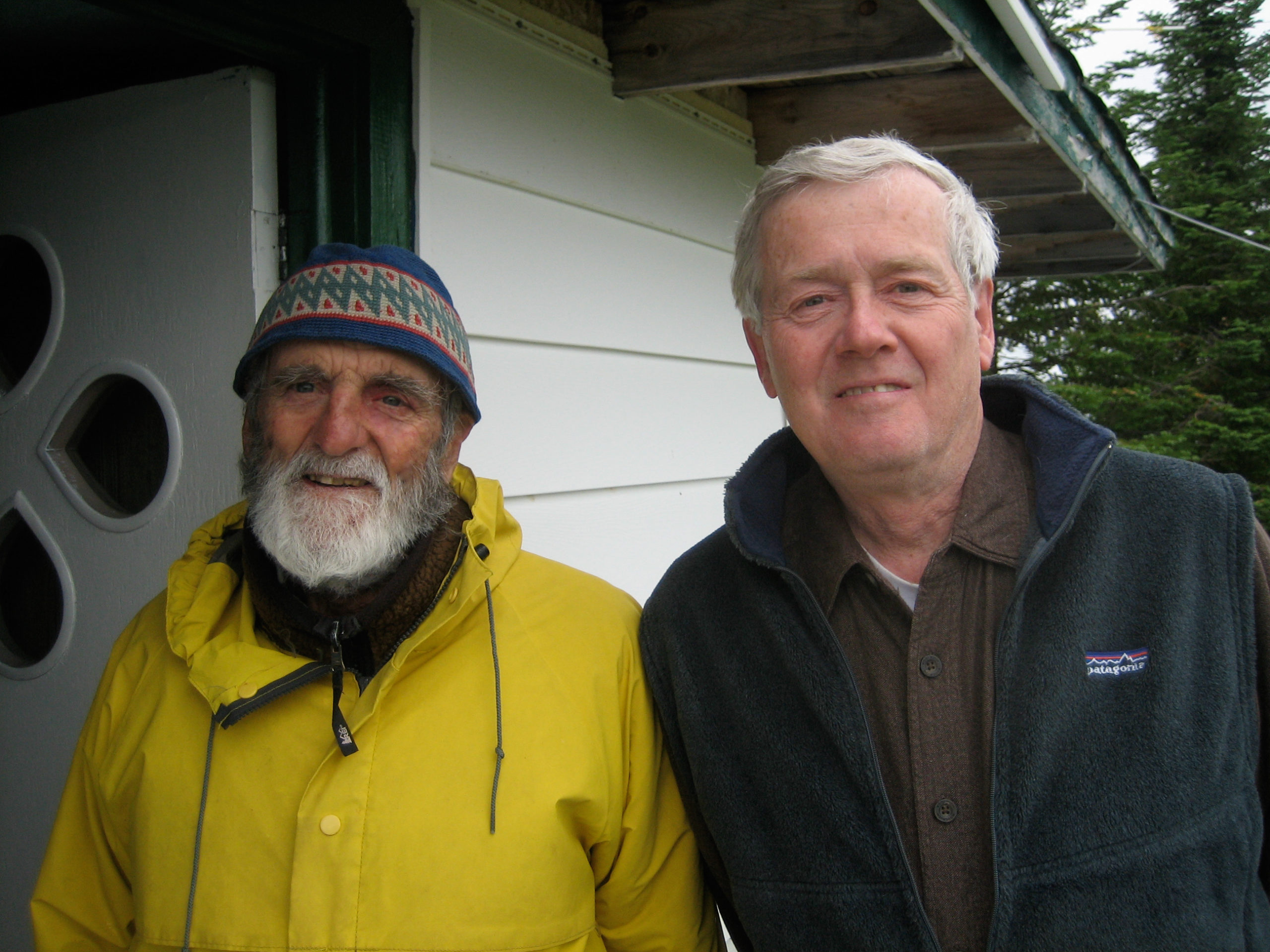By R. John Gibson and Richard L. Haedrich
Editor’s Preface: Dr. John Gibson and Dr. Richard Haedrich were long time supporters of Nature Newfoundland and Labrador (Nature NL) and they made many contributions to science. I had the pleasure of knowing Dr. Gibson through Nature NL and Dr. Haedrich through my studies at Memorial University. Within the past two years, these two “greats” in fish biology have passed away. The following is a reprint of their article on pike in Minipi Lake (Gibson and Haedrich 2010). While technical in nature, the article shows the scientific lens through which these men explored the natural world and how much they enjoyed it. Special thanks to Jack and Lorraine Cooper of Cooper’s Minipi Lodge for providing additional photos for the article. – Justin So

This past summer we were invited by Jack Cooper (of Coopers’ Minipi Camps, Labrador) to his camp at Minipi Lake. The camp is at the northern end of the lake, near the outlet river, about 90 km southwest of Happy Valley-Goose Bay, and is reached by float plane. Jack has four well equipped camps throughout the watershed, with every modern convenience. The system is best known for giant brook trout (Salvelinus fontinalis) which can be caught up to 10 lbs in weight. Large Arctic char (Salvelinus alpinus) also provide angling, averaging 7 lbs but also up to ten pounds. Angling is permitted by fly only, and most fish are returned to the water. The system therefore retains its unique giant brook trout stocks. Jack’s motto for his camps is “The Way It Was Is How It Is,” an unusual and very welcome situation in these modern times.
Minipi Lake is a large lake, 35 miles (56 km) in length and relatively shallow. Dr. David Larson found that the insect fauna is a rich one, and that large-bodied insects are very abundant. Some systems produce large fish related to the abundance or size of food, such as the trophy trout of Star Lake in central Newfoundland feeding mainly on dwarf arctic char (both the trophy trout and the dwarf char now unfortunately are virtually extinct after the lake was turned into a fluctuating hydroelectric reservoir in 1997, see Gibson et al., 2008), but the exceptional size of Minipi trout is probably due to the presence of pike (Esox lucius). ‘Small’ trout, up to about 30 cm in length, are found in the rivers, but only migrate to the lake after exceeding this size, and becoming quite ‘slab sided,’ to avoid predation by the pike. This strategy is sometimes called a ‘size refuge.’ The pike are very numerous and large, reaching 20 lbs in weight.


Our trip took place between July 1 and July 8 [2009], and our main purpose was to get an estimate of the pike abundance. We caught pike by angling, on a fly rod, casting and trolling poppers and streamers. This actually is enormous fun, as they are a very strong and active fish. Each pike was tagged with a Floy tag, embedded in the bones below the dorsal fin with a special ‘gun,’ and released. We fished in a bay near the river outlet, and estimated population size by the multiple catch and release method. The bay we fished was about 12.4 ha in area, 1 to 2 m in depth, with patches of underwater vegetation, and we could see pike from the boat. Over the seven days we fished, we caught 95 pike, and estimated a population size of 106 (95% confidence level (C.L.) 70 – 200), which was about 8.6 fish/ha (C.L. 5.7 – 16.2). All the pike we caught were large, most about 4 to 5 lbs, but the largest was 14 lbs in weight, and the second largest 10 ½ lbs. The first two days were ‘scorchers,’ after which the air temperature dropped remarkably. The water temperature over the week dropped from 24°C to 12°C, and probably affected the success rate. On July 2 to 4, our catch rate for the two anglers was 6.2 fish/hr, dropping to 2.4 /hr on July 7. The optimum temperature for linear growth in the natural environment for pike is 19.8 + 0.6°C (Casselman 1978), which would affect activity.
Pike spawn over flooded vegetation in shallow, sheltered areas in spring, shortly after ice-out (Casselman and Lewis 1996). Pike stocks can be limited by lack of suitable spawning areas, and in some places have declined due to loss of marshy areas, but suitable sites are not limiting in Lake Minipi. Optimal juvenile and adult habitat requires vegetative cover that ranges from 35% to 80%, the amount inversely correlated with pike body size (Casselman and Lewis 1996). Conditions appear favourable in Minipi for all age groups.
In two highly productive rivers in southern England, densities of pike older than 0+ ranged from 32/ha to 80/ha (Mann 1980). The population densities were considered high related to other English waters. Pierce and Tomcko (2003; 2005) found in a number of Minnesota lakes that the densities of pike greater than 350 mm total length ranged from 3.2 to 59.0 fish/ha. Densities of pike over 600 mm averaged only 1.6 fish/ha. They remark that because old fish are susceptible to over fishing, management aimed at producing large fish must severely restrict the harvest of large fish.
The pike of Minipi are virtually unexploited, contributing to the high densities of large fish. Forage fish include suckers (Catostomus catostomus, Catostomus commersoni), lake chub (Couesius plumbeus), and burbot (Lota lota) in addition to trout when the opportunity presents itself. Small pike, and sometimes large pike, eat invertebrates. Pike are exceedingly voracious, are cannibalistic, and will also take small mammals and small waterfowl (perhaps that is why loons at first carry their young on their backs?). One of the Minipi guides, Kelly Groves, told us that he had seen a pike thrashing at the surface, probably suffocating, with a 2 lb sucker stuck in its gullet, and another similar incident where a 3 lb arctic char was stuck in the pike’s gullet. The strike of pike on a lure as they come up from the depths is very exciting. Pike fishing at Minipi can be a lot of fun!


Wildlife of course was around, such as moose, otter and loon, and we saw bears a couple of times (see photo). As a postscript, a month after our trip, four bears broke into Minipi Lodge and trashed it. They left through the plate glass windows, leaving Jack and his staff to clean up the mess and put the lodge back in order. That’s much easier said than done, and just goes to show that operating a wilderness camp can have pitfalls and problems that few small businesses have to deal with.
References
Casselman, J.M. and C.A. Lewis. 1996. Habitat requirements of northern pike (Esox lucius). Canadian Journal of Fisheries and Aquatic Sciences 53 (Suppl. 1): 161-174.
Gibson, R.J., R.L. Haedrich, J.C. Kennedy, K. Vodden, and C.M. Wernerheim. 2008. Promoting, blocking and diverting the flow of knowledge: four case studies from Newfoundland and Labrador. Chapter 9, pp. 155-177, in: J.S. Lutz and B. Neis (eds), Making and Moving Knowledge: Interdisciplinary and Community-based Research for a World on the Edge. McGill-Queen’s University Press, Montreal. Mann, R.H.K. 1980. The numbers and production of pike (Esox lucius) in two Dorset rivers. Journal of Animal Ecology 49: 899-915.
Pierce, R.B. and C.M. Tomcko. 2003. Interrelationships among production, density, growth and mortality of northern pike in seven north-central Minnesota lakes. Transactions of the American Fisheries Society 132: 143-153.
Pierce, R.B. and C.M. Tomcko. 2005. Density and biomass of native northern pike populations in relation to basin-scale characteristics of north-central Minnesota lakes. Transactions of the American Fisheries Society 134: 231-241.
Article republished from Gibson, R.J., and R.L. Haedrich (2010) Pike population in Minipi Lake, Labrador. The Osprey. 41(2): 23-25.
